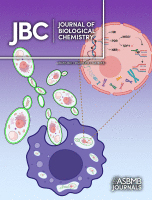- Submit a Protocol
- Receive Our Alerts
- Log in
- /
- Sign up
- My Bio Page
- Edit My Profile
- Change Password
- Log Out
- EN
- EN - English
- CN - 中文
- Protocols
- Articles and Issues
- For Authors
- About
- Become a Reviewer
- EN - English
- CN - 中文
- Home
- Protocols
- Articles and Issues
- For Authors
- About
- Become a Reviewer
An Optimized Protocol for Simultaneous Propagation of Patient-derived Organoids and Matching CAFs
Published: Vol 15, Iss 2, Jan 20, 2025 DOI: 10.21769/BioProtoc.5160 Views: 3317
Reviewed by: Anca Flavia Savulescuilgen Mender

Protocol Collections
Comprehensive collections of detailed, peer-reviewed protocols focusing on specific topics
Related protocols
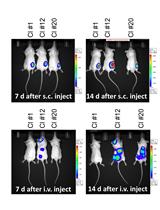
Generation of Luciferase-expressing Tumor Cell Lines
Todd V. Brennan [...] Yiping Yang
Apr 20, 2018 19060 Views
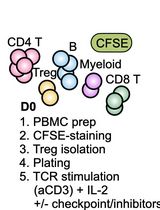
Assessing Human Treg Suppression at Single-Cell Resolution Using Mass Cytometry
Jonas Nørskov Søndergaard [...] James B. Wing
Aug 20, 2025 1718 Views
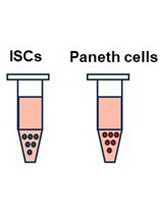
Isolation and Co-culture of Paneth Cells and Intestinal Stem Cells
Ryosuke Isotani [...] Toshimasa Yamauchi
Sep 20, 2025 1815 Views
Abstract
Recurrent hormone receptor-positive (HR+) breast cancer is a leading cause of cancer mortality in women. Recurrence and resistance to targeted therapies have been difficult to study due to the long clinical course of the disease, the complex nature of resistance, and the lack of clinically relevant model systems. Existing models are limited to a few HR+ cell lines, organoid models, and patient-derived xenograft models, all lacking components of the human tumor microenvironment. Furthermore, the low take rate and loss of estrogen receptor (ER) expression in patient-derived organoids (PDOs) has been challenging. Our protocol allows simultaneous isolation of PDOs and matching cancer-associated fibroblasts (CAFs) from primary and metastatic HR+ breast cancers. Importantly, our protocol has a higher take rate and enables long-term culturing of PDOs that retain ER expression. Our matching PDOs and CAFs will provide researchers with a new resource to study the influence of the tumor microenvironment on various aspects of cancer biology such as cell growth and drug resistance in HR+ breast cancer.
Key features
• Propagation of patient-derived organoids and matching cancer-associated fibroblasts from primary and metastatic hormone receptor (HR+) positive breast cancer.
• Optimized media for long-term culturing of HR+ organoids from primary tumors and bone metastasis.
• Co-culture model to assess the influence of the tumor stroma on breast cancer progression.
Keywords: Patient-derived organoidsGraphical overview
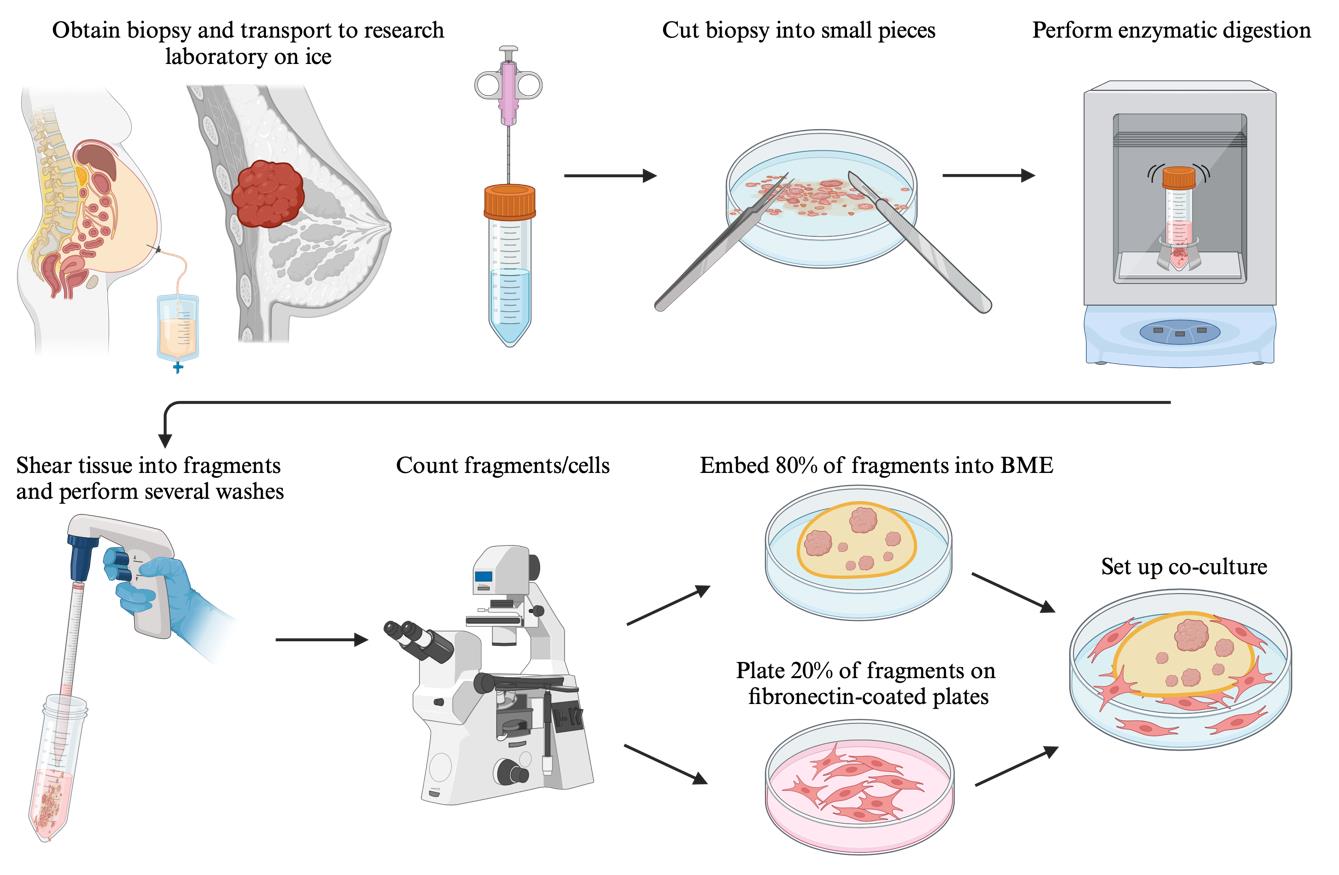 Graphical overview of the key steps for establishing patient-derived organoid cultures and matching cancer-associated fibroblasts from hormone receptor-positive breast cancer
Graphical overview of the key steps for establishing patient-derived organoid cultures and matching cancer-associated fibroblasts from hormone receptor-positive breast cancer
Background
Breast cancer is the second leading cause of cancer-related mortality in women with over 600,000 deaths yearly. The majority of newly diagnosed breast cancers are hormone receptor-positive (HR+), expressing estrogen receptor (ER) with or without progesterone receptor (PR) [1]. These patients are treated with targeted therapies, such as endocrine therapies and CDK4/6 inhibitors [2]. Although HR+ breast cancers typically respond well to these therapies, approximately 30% of the patients will relapse. Unfortunately, recurrent HR+ breast tumors are usually metastatic and incurable. Besides tumor-intrinsic factors, the breast tumor microenvironment contributes to adaptive resistance [3]. Cancer-associated fibroblasts (CAFs) significantly impact tumor biology and are known to induce resistance to targeted therapies [4–9]. Despite this, CAFs are rarely incorporated into studies on breast cancer recurrence and resistance.
Patient-derived organoids (PDOs) are 3-dimensional multicellular clusters that are grown in basement membrane extract (BME). PDOs have self-renewal and self-organization capabilities and retain several features of the original tumor such as morphology and mutational landscape [10]. Compared to the traditional 2-dimensional cell cultures, PDOs capture intratumoral heterogeneity and are superior at predicting drug responses. To date, PDOs have been generated from several tumors, including breast cancer [11–13]. However, growing HR+ PDOs has been a challenge due to a low take rate (10%), overgrowth of normal breast epithelial cells, and the PDOs losing their HR expression and ceasing to grow after only a few passages [14,15]. In addition to PDOs, breast tumor organoids can be propagated from patient-derived xenografts (PDxO) [16,17]. Similar to the HR+ PDOs, HR+ PDxOs have a take rate of 9% for primary tumors and 16% for metastatic tumors. Currently, there are only a few models of metastatic HR+ breast cancer available [16,18]. Thus, there is an unmet need for novel models of HR+ primary and metastatic breast cancer that would advance our understanding of HR+ disease relapse and drug resistance.
We set out to develop patient-derived model systems for HR+ breast cancer that would also incorporate elements of the tumor microenvironment. Our optimized protocol allows for the efficient generation of HR+ PDOs from both primary and metastatic HR+ breast cancer with ~50% take rate. Importantly, we further optimized the media to support isolation and long-term passaging of HR+ bone metastasis that has been extremely difficult to grow. Our method also provides the advantage of reducing the cost and time by circumventing the necessity to passage through a mouse host. Furthermore, we isolate the matching CAFs that most protocols discard; thus, our optimized protocol offers the advantage of enabling the investigation of resistance mechanisms induced by the CAFs. Besides utilizing the patient-derived model for studying HR+ breast cancer and drug resistance [19–21], this model system can be applied to studying various aspects of tumor-stroma interactions.
Materials and reagents
Biological materials
1. Core needle biopsy, primary or metastatic breast cancer
2. Fine-needle aspiration (FNA), lymph node positive for tumor cells
3. Ascites, pleural, or peritoneal fluid
Reagents
1. Phosphate buffered saline (PBS) (Cytiva, catalog number: SH30028.FS)
2. Penicillin-streptomycin (Pen/Strep), 100× (Thermo Fisher, catalog number: 15140122)
3. Dispase-II solution (Sigma, catalog number: SCM133)
4. Collagenase type I (Sigma, catalog number: SCR103)
5. Human fibronectin solution (Sigma, catalog number: F0556)
6. Glucose solution, 200 g/L (Thermo Fisher, catalog number: A24940-01)
7. L-Glutamine solution, 200× (Thermo Fisher, catalog number: 25030-081)
8. HEPES solution, 1M (Sigma, catalog number: H0887-100ML)
9. Y-27632 2HCl, 10 mg (Selleckchem, catalog number: S1049)
10. Advanced DMEM/F12, 1× (Gibco, catalog number: 12634-010)
11. Primocin, 500 mg (InvivoGen, catalog number: ant-pm-05)
12. B27 supplement, 50× (Thermo Fisher, catalog number: 17504044)
13. Nicotinamide (Sigma, catalog number: N0636)
14. N-Acetyl-L-Cysteine (Sigma, catalog number: A9165)
15. A82-01 (Tocris, catalog number: 2939)
16. SB202190 (Selleckchem, catalog number: S1077)
17. 17β-Estradiol (Sigma, catalog number: 3301)
18. Hydrocortisone (Sigma, catalog number: H0888)
19. Human EGF (Thermo Fisher, catalog number: AF-100-15)
20. Human R-Spondin3 (Thermo Fisher, catalog number: 120-44)
21. Human noggin (Thermo Fisher, catalog number: 120-10C)
22. Human heregulin-β1 (Thermo Fisher, catalog number: 100-03)
23. Human FGF7 (Thermo Fisher, catalog number: 100-19)
24. Human FGF10 (Thermo Fisher, catalog number: 100-26)
25. Human CXCL12 (Thermo Fisher, catalog number: 300-28A)
26. Human IGF-I (Thermo Fisher, catalog number: 100-11)
27. Human osteopontin (Thermo Fisher, catalog number: 120-35)
28. Cultrex growth factor–reduced basement membrane extract type II (Fisher Scientific, catalog number: 353301002P)
29. Human fibroblast expansion basal medium, 1× (Thermo Fisher, catalog number: M106500)
30. Low serum growth supplement, 50× (Thermo Fisher, catalog number: S00310)
31. Fetal bovine serum (FBS) (R&D Systems, catalog number: S11550H)
32. Trypsin-EDTA, 0.25% (Thermo Fisher, catalog number: 25200056)
33. TrypLE Express, 1× (Thermo Fisher, catalog number: 12604013)
34. Dimethyl sulfoxide (DMSO) (Sigma, catalog number: D2650)
35. Corning cell recovery solution (Corning, catalog number: 354253)
36. CryoStor CS10 cryopreservation media (Sigma, catalog number: C2874)
37. Paraformaldehyde (PFA), 16%, EM grade (Electron Microscopy Sciences, catalog number: 15710-S)
38. HistoGelTM (Fisher Scientific, catalog number: 22-110-678)
39. Hematoxylin (Sigma, catalog number: MHS32-1L)
40. 10% formalin (Electron Microscopy Sciences, catalog number: 15740-04)
41. Bovine serum albumin (BSA) (Sigma, catalog number: A8806)
42. Goat serum (Thermo Fisher, catalog number: 16210064)
43. Triton X-100 (Sigma, catalog number: X100-500ML)
44. Cytoseal 60 (Fisher Scientific, catalog number: 23-244256)
45. Vectashield antifade mounting medium with DAPI (Fisher Scientific, catalog number: NC9524612)
46. Primary antibodies (Table 1)
Table 1. Primary antibodies for validation of ER status and characterization of CAFs
| Antibody | Host | Company | Catalog number |
|---|---|---|---|
| Estrogen receptor | rabbit | Abcam | ab16666 |
| Alexa 488 anti-rabbit secondary antibody | goat | Thermo Fisher | A-11008 |
| Fibronectin 1 (FN1) | mouse | Thermo Fisher | MA5-1198 |
| Platelet-derived growth factor receptor α (PDGFRα) | rabbit | Cell Signaling Technology | 3174 |
| Vimentin (VIM) | rabbit | Cell Signaling Technology | 5741 |
| α-Smooth muscle actin (αSMA) | rabbit | Abcam | ab5694 |
| Caveolin 1 (CAV1) | rabbit | Cell Signaling Technology | 3267 |
| Fibroblast activating protein (FAP) | rabbit | Cell Signaling Technology | 66562 |
| Podoplanin (PDPN) | rabbit | Cell Signaling Technology | 9047 |
| Thy1 cell surface antigen (THY1) | rabbit | Cell Signaling Technology | 13801 |
Solutions
1. Biopsy collection solution (see Recipes)
2. Digestion solution (see Recipes)
3. PDO isolation wash solution (see Recipes)
4. Fibronectin coating solution (see Recipes)
5. Breast PDO media (see Recipes)
6. Bone metastasis PDO media (see Recipes)
7. Fibroblast media (see Recipes)
8. Freezing media (see Recipes)
9. IF blocking buffer (see Recipes)
10. IF wash buffer (see Recipes)
Recipes
1. Biopsy collection solution (500 mL)
| Reagent | Final concentration | Quantity or Volume |
|---|---|---|
| PBS | n/a | 500 mL |
| Pen/Strep 100× | 1× | 5 mL |
| Glucose (200 g/L) | 4.5 g/L | 11.25 mL |
2. Digestion solution (10 mL)
Make fresh for every digestion. Sterile filter before use.
| Reagent | Final concentration | Quantity or Volume |
|---|---|---|
| Dispase-II solution 1× | n/a | 10 mL |
| Collagenase-I (200 mg/mL) | 2 mg/mL | 100 μL |
| Y-27632 2HCl (5 mM) | 5 μM | 10 μL |
3. PDO wash solution (500 mL)
| Reagent | Final concentration | Quantity or Volume |
|---|---|---|
| Advanced DMEM/F12 | n/a | 500 mL |
| Glutamine (200 mM) | 2 mM | 5 mL |
| HEPES (1 M) | 10 mM | 5 mL |
| Pen/Strep (100×) | 1× | 5 mL |
| Primocin (50 mg/mL) | 50 μg/mL | 500 μL |
4. Fibronectin coating solution (5 mL)
| Reagent | Final concentration | Quantity or Volume |
|---|---|---|
| PBS | n/a | 5 mL |
| Fibronectin 500 μg/mL | 2 μg/mL | 20 μL |
5. Breast PDO media (50 mL)
Store at 4 °C for a maximum of two weeks. Add Y-27632 2HCl only for the first 4–6 days after isolation.
| Reagent | Final concentration | Quantity or Volume |
|---|---|---|
| Advanced DMEM/F12 | n/a | 48 mL |
| Glutamine (200 mM) | 2 mM | 500 μL |
| HEPES (1 M) | 10 mM | 500 μL |
| Pen/Strep (100×) | 1× | 500 μL |
| Primocin (50 mg/mL) | 50 μg/mL | 50 μL |
| B27 supplement (50×) | 1× | 100 μL |
| Nicotinamide (1 M) | 1 mM | 50 μL |
| N-Acetyl-L-Cysteine (500 mM) | 500 μM | 50 μL |
| A82-01 (5 mM) | 500 nM | 5 μL |
| SB202190 (5 mM) | 500 nM | 5 μL |
| 17β-Estradiol (5 μg/mL) | 0.5 ng/mL | 5 μL |
| Hydrocortisone (50 μg/mL) | 50 ng/mL | 50 μL |
| Human EGF (5 μg/mL) | 5 ng/mL | 50 μL |
| Human R-Spondin3 (100 μg/mL) | 200 ng/mL | 100 μL |
| Human noggin (40 μg/mL) | 80 ng/mL | 200 μL |
| Human heregulin-β1 (25 μg/mL) | 25 ng/mL | 50 μL |
| Human FGF7 (10 μg/mL) | 5 ng/mL | 25 μL |
| Human FGF10 (20 μg/mL) | 20 ng/mL | 50 μL |
| Y-27632 2HCl (5 mM) | 5 μM | 10 μL |
6. Bone metastasis PDO media (50 mL)
Store at 4 °C for a maximum of two weeks. Add Y-27632 2HCl only for the first 4–6 days after isolation.
| Reagent | Final concentration | Quantity or Volume |
|---|---|---|
| Advanced DMEM/F12 | n/a | 48 mL |
| Glutamine (200 mM) | 2 mM | 500 μL |
| HEPES (1 M) | 10 mM | 500 μL |
| Pen/Strep (100×) | 1× | 500 μL |
| Primocin (50 mg/mL) | 50 μg/mL | 50 μL |
| B27 supplement (50×) | 1× | 100 μL |
| Nicotinamide (1 M) | 1 mM | 50 μL |
| N-Acetyl-L-Cysteine (500 mM) | 500 μM | 50 μL |
| A82-01 (5 mM) | 500 nM | 5 μL |
| SB202190 (5 mM) | 500 nM | 5 μL |
| 17β-Estradiol (5 μg/mL) | 0.5 ng/mL | 50 μL |
| Hydrocortisone (50 μg/mL) | 50 ng/mL | 50 μL |
| Human recombinant EGF (5 μg/mL) | 5 ng/mL | 50 μL |
| Human R-Spondin3 (100 μg/mL) | 200 ng/mL | 100 μL |
| Human noggin (40 μg/mL) | 80 ng/mL | 200 μL |
| Human heregulin-β1 (25 μg/mL) | 25 ng/mL | 50 μL |
| Human FGF7 (10 μg/mL) | 5 ng/mL | 25 μL |
| Human FGF10 (20 μg/mL) | 20 ng/mL | 50 μL |
| Human CXCL12 (10 μg/mL) | 10 ng/mL | 50 μL |
| Human IGF-I (20 μg/mL) | 20 ng/mL | 50 μL |
| Human osteopontin (10 μg/mL) | 10 ng/mL | 50 μL |
| Y-27632 2HCl (5 mM) | 5 μM | 10 μL |
7. Fibroblast media (500 mL)
| Reagent | Final concentration | Quantity or Volume |
|---|---|---|
| Human fibroblast expansion basal medium 1× | n/a | 500 mL |
| Low serum growth supplement 50× | 1× | 10 mL |
| FBS | 4% | 10 mL |
| Pen/Strep 100× | 1× | 5 mL |
| Primocin 50 mg/mL | 50 μg/mL | 500 μL |
8. Freezing media (5 mL)
| Reagent | Final concentration | Quantity or Volume |
|---|---|---|
| CryoStor CS10 | n/a | 5 mL |
| Y-27632 2HCl (5 mM) | 5 μM | 5 μL |
9. IF blocking buffer (100 mL)
| Reagent | Final concentration | Quantity or Volume |
|---|---|---|
| PBS | n/a | 100 mL |
| BSA | 1% | 1 g |
| Goat serum | 5% | 5 mL |
| Triton X-100 | 0.3% | 300 μL |
10. IF wash buffer (1,000 mL)
| Reagent | Final concentration | Quantity or Volume |
|---|---|---|
| PBS | n/a | 1,000 mL |
| Triton X-100 | 0.3% | 3 mL |
Laboratory supplies
1. 50 mL centrifuge tube (Celltreat, catalog number: 229106)
2. 15 mL centrifuge tube (Celltreat, catalog number: 229411)
3. 25 mL serological pipettes, individually wrapped (Thermo Fisher, catalog number: 170357N)
4. 10 mL serological pipettes, individually wrapped (Thermo Fisher, catalog number:170356N)
5. 1,000 μL pipette tips (VWR, catalog number: 89082-350)
6. 200 μL pipette tips (VWR, catalog number: 89082-366)
7. 20 μL pipette tips (VWR, catalog number 89082-338)
8. 24-well plates (Thermo Fisher, catalog number: 142475)
9. 6-well plates (Thermo Fisher, catalog number: 140675)
10. 10 cm plates (Thermo Fisher, catalog number: 150350)
11. 1.5 mL microcentrifuge tubes (Eppendorf, catalog number: 0030120086)
12. 1.2 mL cryogenic vials (Corning, catalog number: 430487)
13. Mr. FrostyTM freezing container (Thermo Fisher, catalog number: 5100-0050)
14. TissueTek cryomold (VWR, catalog number: 25608-922)
15. #10 Bard-ParkerTM protected disposable scalpel (Fisher Scientific, catalog number: 02-688-78)
16. #11 Bard-ParkerTM protected disposable scalpel (Fisher Scientific, catalog number: 02-688-79)
17. Tissue cassette (VWR, catalog number: 18000-134)
18. BD disposable syringes (Fisher Scientific, catalog number: 14-823-435)
19. 25 G precision glide needles (Fisher Scientific, catalog number: 14-826-49)
20. FalconTM 4-well chamber slides (Fisher Scientific, catalog number: 08-774-209)
21. Coverglass 24 × 60 (Fisher Scientific, catalog number: NC1672857)
22. Forceps (Fisher Scientific, catalog number: 08-953G)
Equipment
1. Laminar flow hood (Baker, model: SterilGARD)
2. Incubator (Thermo, model: Forma Stericycle i160)
3. Centrifuge (Thermo, model: Sorvall legend XI)
4. Cell counter (Countess II FL)
5. Fisherbrand mini-tube rotator (Thermo Fisher, catalog number: 88-861-051)
6. Thermal mixer (Thermo Fisher, catalog number: 13687712)
7. Microscope (Olympus, model: CK2)
8. Microscope (Olympus, model: BX43)
9. Confocal microscope (Zeiss, model: LSM880)
Software and datasets
1. Zeiss (ZEN lite)
2. Fiji (version 2.14.0/1.54f)
Procedure
A. Isolation of patient-derived organoids from core-needle biopsies
1. Collect core-needle biopsies in a 50 mL tube with 10–20 mL of cold biopsy collection solution. Place tube on ice and transport to research laboratory within 30 min.
2. Use forceps to place one biopsy on a 6 cm dish with approximately 500 μL of digestion solution (Figure 1A).
Optional: Remaining biopsies can be placed in a cryotube with freezing media and frozen down and/or fixed using 4% PFA and used for histology. Frozen fragments can be stored at -196 °C for years.
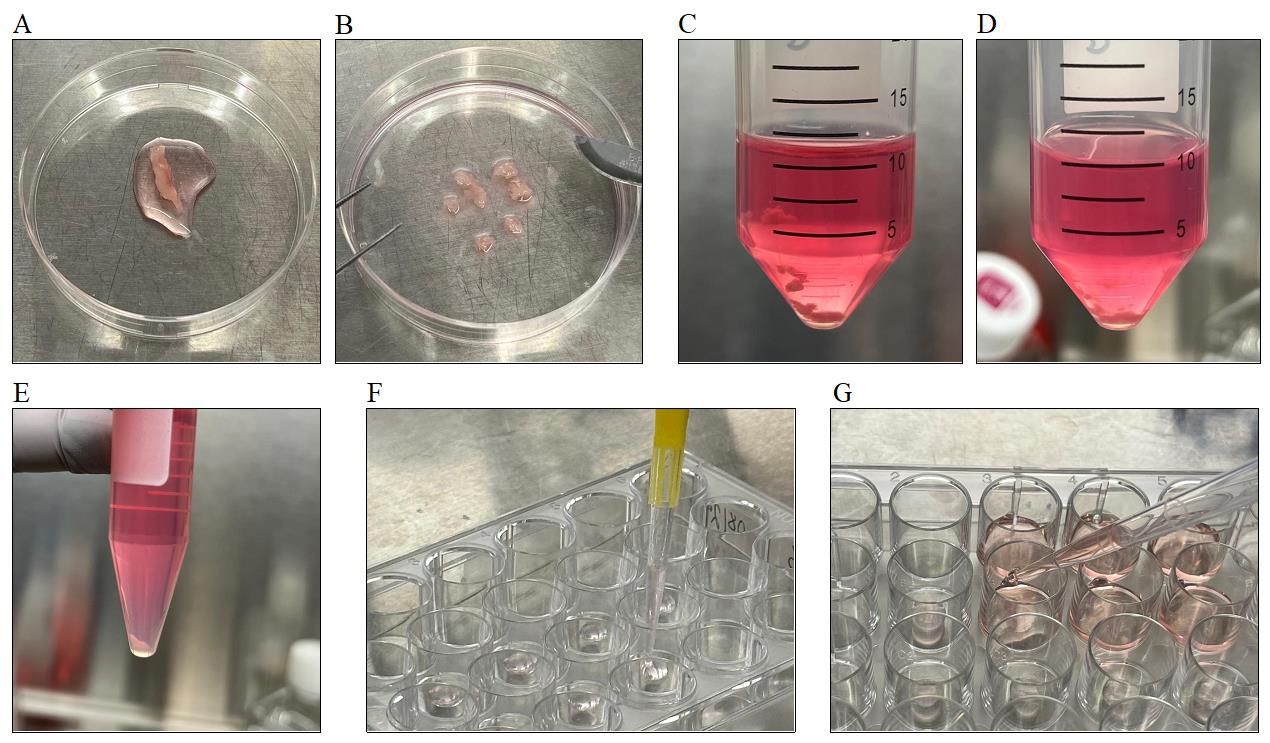
Figure 1. Key steps during the isolation process. A) Place the core-needle biopsy into 500 μL of digestion solution. B) Slice the biopsy into 1–3 mm pieces. C) Move pieces into a 50 mL tube containing 10 mL of digestion solution. D) Stop digestion when pieces appear smaller and/or the digestion solution becomes “cloudy.” E) Spin down supernatant to pellet fragments. F) Pipette 50 μL of Cultrex and fragment mix into the middle of the well. G) Add PDO media by pipetting to the wall of the well.
3. Slice the biopsy into 1–3 mm pieces by using forceps and a 10-blade scalpel.
Note: Scissors can be used instead of a scalpel (Figure 1B).
4. Use forceps to move larger pieces to a 50 mL tube containing digestion solution. Pipette 1 mL of digestion solution to the 6 cm dish and move the solution containing smaller pieces to the 50 mL tube (Figure 1C).
5. Incubate biopsy pieces in an orbital shaker at 220 rpm for 45–60 min at 37 °C. Check on the progression of the digestion every 15 min. Stop the digestion when the pieces are visibly smaller or difficult to detect by the eye, and/or the digestion solution becomes “cloudy” (Figure 1D).
Critical: Do not exceed 60 min.
6. Shear the pieces by vigorously pipetting up and down using a 10 mL serological pipette. Let the fragments settle to the bottom of the tube and move the digestion solution to a new 50 mL tube. Add 10 mL of PDO wash solution supplemented with 5% FBS and pipette the pieces again. Move the wash solution containing tissue fragments to the same 50 mL tube.
7. Spin fragments down at 400× g for 5 min. Remove the supernatant and resuspend using 10 mL of fresh PDO isolation wash buffer (no FBS). Pipette 10 μL onto a glass slide and check for tissue fragments under a microscope. Spin down at 400× g for 5 min (Figure 1E).
Note: Pelleting the tissue fragments can be challenging if the biopsy has a high content of connective tissue, fat, and/or extracellular matrix. We transfer the supernatant into a separate 50 mL tube and store it until we have confirmed that we have obtained tissue fragments.
8. Remove supernatant and resuspend fragments in 1 mL of PDO isolation wash buffer. Count fragments using a hemocytometer and microscope (Olympus CK2). Set aside approximately 200 μL of the suspension for CAF isolation (section C). Pellet the fragments at 400× g for 5 min.
9. Embed fragments into Cultrex.
a. Thaw Cultrex on ice and keep it on ice for the whole duration.
b. Calculate the volume of Cultrex needed for the total number of fragments. Embed 800–1,000 fragments per 50 μL of Cultrex.
c. Carefully aspirate supernatant and resuspend pellet in Cultrex by slowly pipetting up and down using a 200 μL tip. This step should be done on ice.
d. Pipette 50 μL of the mix into the middle of the well on a 24-well plate or a 4-well chamber slide. The 50 μL drop should form a dome in the middle of the well (Figure 1F).
e. Place the 24-well plate into the incubator with standard conditions and incubate for 30 min at 37 °C.
10. Add 500 μL of breast PDO or bone metastasis PDO media supplemented with 5 μM Y-27632 2HCl to each well (Figure 1G). Change media every 4–5 days.
Note: Avoid adding media directly on top of the Cultrex dome.
11. Expand PDO cultures over the next 3–6 weeks. Image (Figure 2A) and freeze down PDOs during each passage.
a. Collect PDOs from 2–3 wells by scraping the bottom of the well with a 1,000 μL pipette tip and move the media and PDOs to a 15 mL tube. Spin down at 350× g for 5 min.
b. Resuspend the pellet with freezing media, move it to cryogenic tubes, and freeze using a Mr. FrostyTM freezing container.
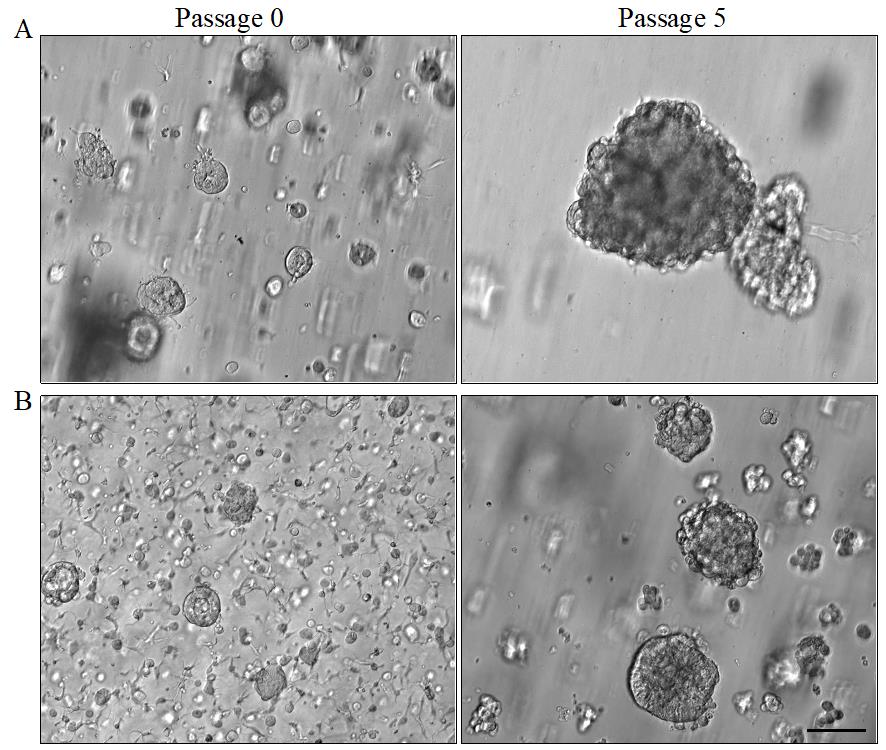
Figure 2. Patient-derived organoids (PDO) morphology at different passages. A) Representative images of PDOs established from a core-needle biopsy. B) Representative images of PDOs established from ascites. Scale bar: 200 μm.
12. Validate ER expression after three passages by immunohistochemistry (see section E) or immunofluorescence staining (see section F).
B. Propagation of patient-derived organoids from fine-needle aspiration or ascites
1. Place the tube or bottle containing pleural/peritoneal fluid or FNA on ice and transport it to the research laboratory.
2. Spin down the fluid for 5 min at 400× g and aspirate supernatant. Repeat this step until all fluid has been pelleted.
3. Wash the pellet with PDO isolation wash solution and spin down for 5 min at 400× g. Repeat this step twice.
4. Resuspend the pellet in 1 mL of PDO isolation wash solution and calculate the cell number. Set aside approximately 200 μL of the suspension for CAF isolation (section C).
5. Embed cells into Cultrex.
a. Thaw Cultrex on ice and keep it on ice for the whole duration.
b. Calculate the volume of Cultrex needed for the total number of fragments. Embed 800–1,000 fragments per 50 μL of Cultrex.
c. Carefully aspirate supernatant and resuspend pellet in Cultrex by slowly pipetting up and down using a 200 μL tip. This step should be done on ice.
d. Pipette 50 μL of the mix into the middle of the well on a 24-well plate. The 50 μL drop should form a dome in the middle of the well (Figure 1F).
e. Place the 24-well plate into the incubator and incubate for 30 min.
6. Add 500 μL of breast PDO media Y-27632 2HCl to each well (Figure 1G). Change media every 4–5 days.
7. Expand PDO cultures over the next 3–6 weeks. Image (Figure 2B) and freeze down PDOs during each passage.
a. Collect PDOs from 2–3 wells by scraping the bottom of the well with a 1,000 μL pipette tip and move the media and PDOs to a 15 mL tube. Spin down for 5 min at 350× g.
b. Resuspend the pellet with freezing media, move it to cryogenic tubes, and freeze using a Mr. FrostyTM freezing container.
8. Validate ER expression after three passages by immunohistochemistry (see section E) or immunofluorescence staining (see section F).
C. Isolation and selection of cancer-associated fibroblasts
1. Add 1 mL of fibronectin coating solution per well to a 6-well plate and incubate the plate at 37 °C for 60 min. Wash wells with PBS before plating CAFs. We usually coat 2–3 wells.
2. Plate cell fragments and/or cells from step A8/B4 (Figure 1E) and add 2 mL of fibroblast media.
3. Enrich for CAFs by short trypsinization. CAFs proliferate faster than cancer cells and can be easily distinguished based on the elongated morphology. We usually observe cancer cells in 5%–10% of the initial CAF cultures (Figure 3). In case both CAFs and cancer cells are observed, perform a short trypsinization that will detach CAFs but leave cancer cells attached.
a. Aspirate media, wash cells with 4 mL of PBS, and add 1 mL of Trypsin-EDTA.
b. Incubate at 37 °C for a maximum of 5 min. Check on the cells every minute. Once cells start to detach, gently move the trypsin-containing CAFs into a 15 mL tube with 5 mL of fibroblast media.
Critical: Do not pipette or tap the plate to aid detachment.
c. Spin down at 350× g for 5 min and plate 1 × 106 cells/6 cm plate.
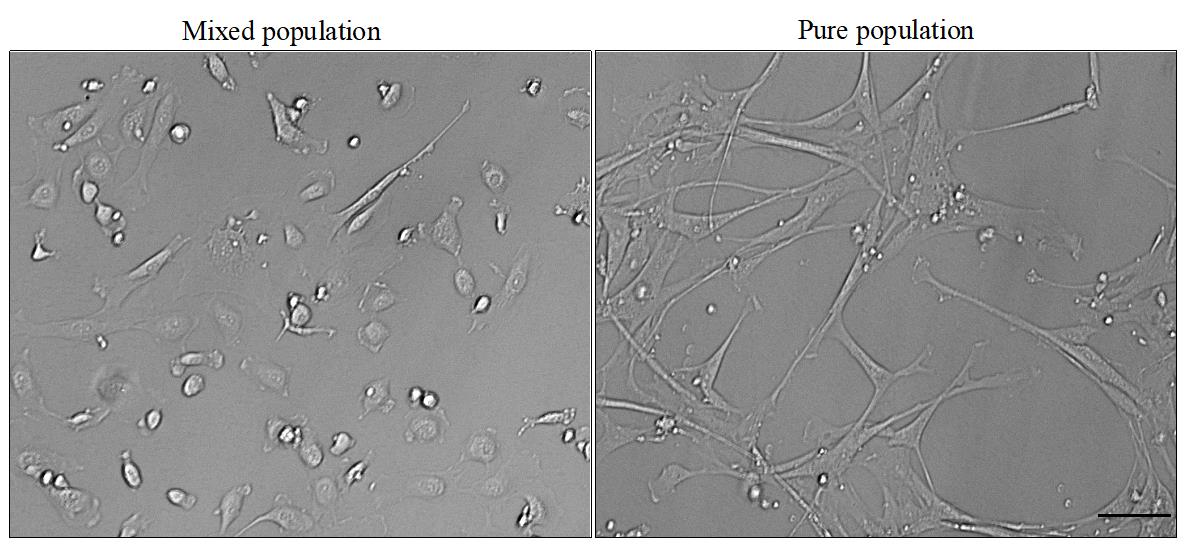
Figure 3. Representative images of a mixed population and a pure cancer-associated fibroblast (CAF) population. Scale bar: 200 μm.
4. Expand the CAFs over the next 3–6 weeks and freeze down early passages.
a. Wash plates with PBS, add 1.5 mL of trypsin-EDTA, and incubate for 5 min at 37 °C.
Note: Some CAF lines secret high amounts of extracellular matrix, which appears as a viscous membrane. We usually extend the incubation time with trypsin to allow complete detachment.
b. Add 6 mL of fibroblast media, move the suspension to a 15 mL tube, and pellet the CAFs at 350× g for 5 min.
c. Resuspend the pellet with freezing solution, move it to cryogenic tubes, and freeze using a Mr. FrostyTM freezing container. CAFs can be stored for years at -196 °C.
5. Characterize the CAFs by performing standard western blotting using the following fibroblast markers: FN1 (1:1,000), PDGFRα (1:1,000), αSMA (1:1,000), VIM1 (1:1,000), FAP, (1:1,000), THY1 (1:1,000), and PDPN (1:1,000).
D. Set up co-culture model
1. Collect and pellet PDOs from several wells by scraping the bottom of the well with a 1,000 μL pipette tip and move the media and PDOs to a 15 mL tube. Spin down for 5 min at 350× g.
2. Carefully aspirate the supernatant, add digestion solution, and incubate at 37 °C for 30–45 min. We add 500 μL of digestion solution per collected well.
Note: The pellet containing PDOs and Cultrex detaches easily from the bottom of the tube. We usually use a 1,000 μL pipette to remove the top layer of Cultrex.
3. Add 1 mL of PDO wash buffer, shear the PDOs by passing through a 25 G needle 10–20 times, and add 10 mL of PDO wash solution supplemented with 5% FBS. Some PDO lines are more difficult to break down into smaller fragments and require a 5 min TrypLE Express treatment. We advise to always passage new PDO lines with the digestion solution. Spin down for 5 min at 350× g, add 1 mL of PDO wash solution, and count the fragments.
4. Embed 200–600 fragments/well in the same way as in steps A9 and A10. Set up PDO cultures on a 24-well plate if the endpoint is a biochemical assay such as RNA isolation, or Falcon 4-well chamber slides for immunostainings (Figure 4).
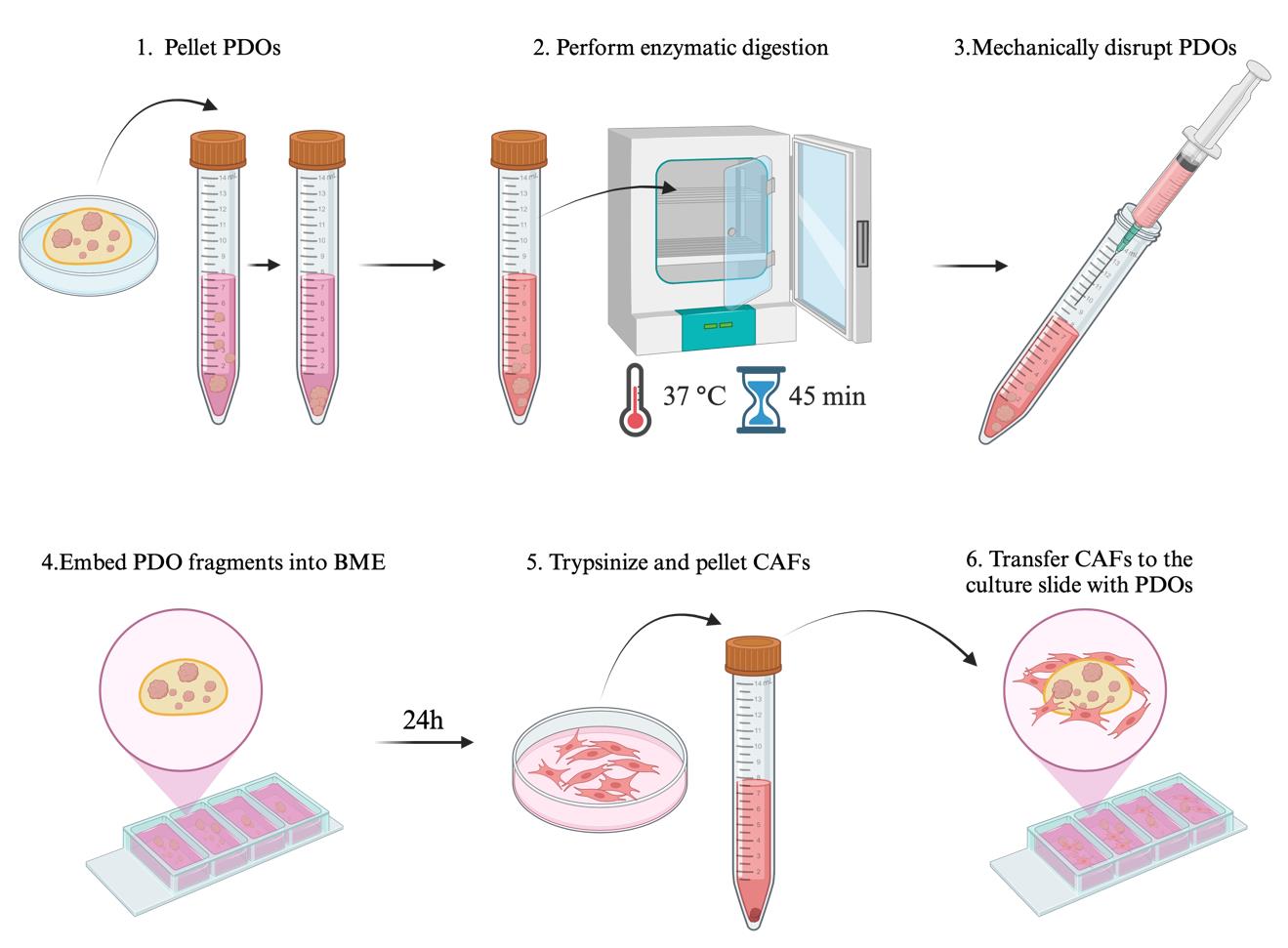
Figure 4. Key steps for setting up a patient-derived organoid–cancer-associated fibroblast (PDO-CAF) co-culture
5. Set up co-culture 24 h later. Aspirate media, wash CAFs with PBS, and add 2 mL of trypsin to a 10 cm plate. Incubate for 5 min at 37 °C, add fibroblast media, and pellet cells in a 15 mL tube for 5 min at 350× g. Aspirate supernatant, resuspend pellet in 1 mL of fibroblast media, and count the cells.
6. Add 2,000–6,000 CAFs per well. The CAF number depends on how fast the CAF line proliferates.
a. Resuspend the correct amount of CAFs in breast PDO media or bone metastasis PDO media.
b. Pipette 500 μL of the suspension around the PDO dome.
c. Wait 24 h before starting any experiments with the co-cultures.
d. The length of the co-culture depends on the downstream application. We assess drug resistance for 4–5 days.
E. Embed PDOs in HistoGel
1. Collect PDOs from two wells by scraping the bottom of the well with a 1,000 μL pipette tip and move the media and PDOs to a 15 mL tube. Spin down for 5 min at 350× g.
2. Aspirate media, resuspend pellet in 1,000 μL of Corning cell recovery solution, and transfer the PDOs to a microcentrifuge tube.
3. Extract PDOs by incubating for 45–60 min at 4 °C on a rotor.
4. Set up inserts while PDOs are on the rotor.
a. Preheat HistoGel at 65 °C.
b. Cut the tip of a 200 μL tip and carefully add 200 μL of HistoGel to a cryomold. Avoid air bubbles.
c. Place the insert on ice.
5. Spin down PDOs for 5 min at 350× g, aspirate the supernatant, and fix PDOs in 500 μL of 4% PFA for 30 min at room temperature.
6. Add 1,000 μL of PBS, spin down for 5 min at 350× g, and aspirate the supernatant.
7. Stain PDOs using hematoxylin.
Note: This step is optional. We recommend staining the PDOs with hematoxylin as it makes the PDOs visible and easier to complete the remaining steps.
a. Gently resuspend pellet in 100 μL of hematoxylin and incubate for 5 min.
b. Add 1,000 μL of PBS, spin down for 5 min at 350× g, and carefully aspirate the supernatant.
8. Embed PDOs in HistoGel.
a. Cut the tip of a 200 μL tip and resuspend PDOs in 200 μL of preheated HistoGel.
b. Pipette the HistoGel and PDO mix on top of the cooled-down HistoGel layer from step F4.
c. Place cryomold on ice and incubate for at least 20 min.
d. Use an 11-blade scalpel to cut the HistoGel along the cryomold walls, invert the cryomold, and remove the HistoGel by gently pressing at the top of the cryomold.
e. Place HistoGel with PDOs into a tissue cassette.
9. Fix PDOs overnight at room temperature in 10% formalin and wash with PBS.
10. Embed in paraffin using standard protocol and stain for ER (1:100). Image using an Olympus BX43 microscope or similar.
F. Validation of ER expression by immunofluorescence staining
1. Aspirate media and fix PDOs in 500 μL of 4% PFA for 30 min at room temperature.
2. Gently remove PFA using a 1,000 μL pipette.
Note: The Cultrex dome becomes fragile and may spread toward the walls of the well during fixation. We usually aspirate the media from one corner of the well.
3. Wash with 500 μL of PBS. Repeat two times.
4. Permeabilize and block for 1 h at room temperature using 500 μL of blocking buffer.
5. Dilute ER antibody in blocking buffer at 1:100 ratio and incubate overnight at 4 °C.
6. Wash 10 times with IF wash buffer.
7. Dilute goat anti-rabbit secondary antibody 1:500 in blocking buffer and incubate for 2 h at RT.
Critical: Alexa 488 secondary antibody is light sensitive. Keep the culture slide covered from this step onward.
8. Wash 10 times with IF wash buffer.
9. Mount culture slide.
a. Wash once with H2O and carefully remove all H2O.
b. Remove the wells using the tool included with the culture slides.
c. Add Cytoseal 60 around the outer border of the culture slides.
d. Add a drop of Vectashield per well.
e. Gently press a coverslip on top of the culture slide. Avoid air bubbles.
f. Seal the staining by adding Cytoseal 60 around the outer border of the coverslip.
10. Image using a confocal microscope (Figure 5). We use a Zeiss LSM880 confocal microscope and Zeiss Zen Lite to convert acquired czi images into TIF format. Zeiss Zen Lite is the free version of Zen for basic image analysis.
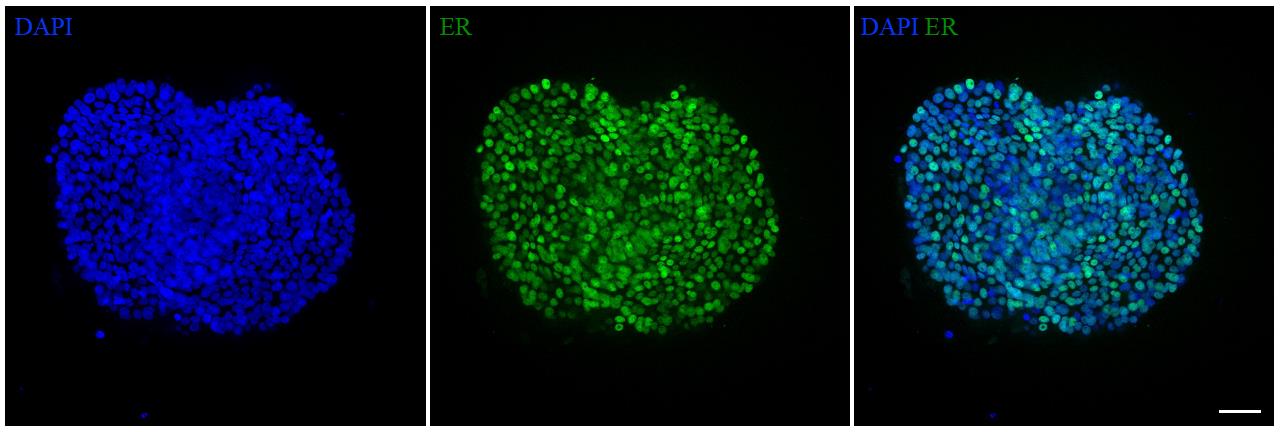
Figure 5. Validation of estrogen receptor (ER) expression in patient-derived organoids (PDOs). Representative confocal image of ER- and DAPI-stained PDO. Scale bar: 40 μm.
Validation of protocol
This protocol or parts of it has been used and validated in the following research article(s):
Hogstrom et al. [20]. Simultaneous isolation of hormone receptor–positive breast cancer organoids and fibroblasts reveals stroma-mediated resistance mechanisms. Journal of Biological Chemistry [(Figure 1; Figure S1; Figure 2, panel A, B, D; Figure S2; Figure 3, panel B; Figure S3; Figure 5, panel B, C; Figure S5, panel A).
Hillis et al. [21]. Targeting Cholesterol Biosynthesis with Statins Synergizes with AKT Inhibitors in Triple-Negative Breast Cancer. Cancer Research. [(Figure 3, panel E–F; Supplementary figure S7)]
Choi et al. [19]. Lineage-specific silencing of PSAT1 induces serine auxotrophy and sensitivity to dietary serine starvation in luminal breast tumors. Cell Reports. [Figure 4, panel A, B, C, D).
General notes and troubleshooting
General notes
1. Our media recipe will support the growth of normal breast tissue. Similar to other published protocols, PDO cultures that are generated from primary tumors may be contaminated with normal breast organoids. It is important to validate ER expression and histology after three passages.
2. We recommend processing one biopsy and freezing down any additional biopsies as a backup.
3. Establishing and expanding PDOs and CAFs takes approximately 3–6 weeks. We set up co-cultures for downstream analysis once we have validated ER expression in PDOs and characterized CAFs with fibroblast markers. This usually takes place 4–8 weeks after establishing new PDO and CAF lines.
4. CAFs can be passaged 10–20 times before they undergo senescence. We recommend freezing as many vials as possible.
Troubleshooting
Problem 1: See General notes, point 1, regarding normal tissue contaminating the tumor PDOs.
Possible cause: The media supports the growth of normal breast tissue.
Solution: Validate the PDOs for tumor-specific markers, such as ER staining.
Problem 2: See General notes, point 3, regarding CAF undergoing senescence.
Possible cause: It is normal for CAFs to undergo senescence as they are not tumorigenic.
Solution: CAFs can be immortalized using hTERT to maintain replicative capacity beyond 20 passages. However, they will not be considered normal CAFs anymore at this point.
Acknowledgments
We thank all authors from our corresponding original research paper in the Journal of Biological Chemistry (2023) [20]. This research was supported by Susan G. Komen Foundation grant# CCR18547665, Harvard Stem Cell Institute grant # DP-0194-21-00, NIH/NCI grants #R00CA180221 and R21CA292302-01, and Ludwig Center at Harvard grant to T.M., J.M.H. was supported by Sigrid Juselius Foundation, Orion Research Foundation, Maud Kuistila Memorial Foundation and AACR-AstraZeneca Breast Cancer Research fellowship grant# 23-40-12-HOGS.
Figure 1 and Figure 4 were created in BioRender, License identifier: Muranen, T. (2024) BioRender.com/w03f535 and Muranen, T. (2024) BioRender.com/l38q446.
Competing interests
The authors declare that there are no conflicts of interest regarding the publication of this paper.
Ethical considerations
All experiments with human subjects were included in the IRB protocol that was reviewed by Dana-Farber/Harvard Cancer Center Scientific Review Committee and Institutional Review Board and approved in 2017 (#17-627). Informed consent was obtained from all participants as per Federal Regulations (45 CFR 46), BIDMC IRB Guidelines, and requirements of HIPAA, and the studies abide by the Declaration of Helsinki principles.
References
- Masoud, V. and Pagès, G. (2017). Targeted therapies in breast cancer: New challenges to fight against resistance. World J Clin Oncol. 8(2): 120.
- Cao, L. Q., Sun, H., Xie, Y., Patel, H., Bo, L., Lin, H. and Chen, Z. S. (2024). Therapeutic evolution in HR+/HER2- breast cancer: from targeted therapy to endocrine therapy. Front Pharmacol. 15: e1340764.
- Raheem, F., Karikalan, S. A., Batalini, F., El Masry, A. and Mina, L. (2023). Metastatic ER+ Breast Cancer: Mechanisms of Resistance and Future Therapeutic Approaches. Int J Mol Sci. 24(22): 16198.
- Chatterjee, S., Bhat, V., Berdnikov, A., Liu, J., Zhang, G., Buchel, E., Safneck, J., Marshall, A. J., Murphy, L. C., Postovit, L. M., et al. (2019). Paracrine Crosstalk between Fibroblasts and ER+ Breast Cancer Cells Creates an IL1β-Enriched Niche that Promotes Tumor Growth. iScience. 19: 388–401.
- Brechbuhl, H. M., Finlay-Schultz, J., Yamamoto, T. M., Gillen, A. E., Cittelly, D. M., Tan, A. C., Sams, S. B., Pillai, M. M., Elias, A. D., Robinson, W. A., et al. (2017). Fibroblast Subtypes Regulate Responsiveness of Luminal Breast Cancer to Estrogen. Clin Cancer Res. 23(7): 1710–1721.
- Marusyk, A., Tabassum, D. P., Janiszewska, M., Place, A. E., Trinh, A., Rozhok, A. I., Pyne, S., Guerriero, J. L., Shu, S., Ekram, M., et al. (2016). Spatial Proximity to Fibroblasts Impacts Molecular Features and Therapeutic Sensitivity of Breast Cancer Cells Influencing Clinical Outcomes. Cancer Res. 76(22): 6495–6506.
- Wang, S. E., Xiang, B., Zent, R., Quaranta, V., Pozzi, A. and Arteaga, C. L. (2009). Transforming Growth Factor β Induces Clustering of HER2 and Integrins by Activating Src-Focal Adhesion Kinase and Receptor Association to the Cytoskeleton. Cancer Res. 69(2): 475–482.
- Janiszewska, M., Stein, S., Metzger Filho, O., Eng, J., Kingston, N. L., Harper, N. W., Rye, I. H., Alečković, M., Trinh, A., Murphy, K. C., et al. (2021). The impact of tumor epithelial and microenvironmental heterogeneity on treatment responses in HER2-positive breast cancer. JCI Insight. 6(11): e147617.
- Sansone, P., Berishaj, M., Rajasekhar, V. K., Ceccarelli, C., Chang, Q., Strillacci, A., Savini, C., Shapiro, L., Bowman, R. L., Mastroleo, C., et al. (2017). Evolution of Cancer Stem-like Cells in Endocrine-Resistant Metastatic Breast Cancers Is Mediated by Stromal Microvesicles. Cancer Res. 77(8): 1927–1941.
- Yang, R. and Yu, Y. (2023). Patient-derived organoids in translational oncology and drug screening. Cancer Lett. 562: 216180.
- Thorel, L., Perréard, M., Florent, R., Divoux, J., Coffy, S., Vincent, A., Gaggioli, C., Guasch, G., Gidrol, X., Weiswald, L. B., et al. (2024). Patient-derived tumor organoids: a new avenue for preclinical research and precision medicine in oncology. Exp Mol Med. 56(7): 1531–1551.
- Sachs, N., de Ligt, J., Kopper, O., Gogola, E., Bounova, G., Weeber, F., Balgobind, A. V., Wind, K., Gracanin, A., Begthel, H., et al. (2018). A Living Biobank of Breast Cancer Organoids Captures Disease Heterogeneity. Cell. 172: 373–386.e10.
- Dekkers, J. F., van Vliet, E. J., Sachs, N., Rosenbluth, J. M., Kopper, O., Rebel, H. G., Wehrens, E. J., Piani, C., Visvader, J. E., Verissimo, C. S., et al. (2021). Long-term culture, genetic manipulation and xenotransplantation of human normal and breast cancer organoids. Nat Protoc. 16(4): 1936–1965.
- Goldhammer, N., Kim, J., Timmermans-Wielenga, V. and Petersen, O. W. (2019). Characterization of organoid cultured human breast cancer. Breast Cancer Res. 21(1): 1–8.
- Campaner, E., Zannini, A., Santorsola, M., Bonazza, D., Bottin, C., Cancila, V., Tripodo, C., Bortul, M., Zanconati, F., Schoeftner, S., et al. (2020). Breast Cancer Organoids Model Patient-Specific Response to Drug Treatment. Cancers. 12(12): 3869.
- Guillen, K. P., Fujita, M., Butterfield, A. J., Scherer, S. D., Bailey, M. H., Chu, Z., DeRose, Y. S., Zhao, L., Cortes-Sanchez, E., Yang, C. H., et al. (2022). A human breast cancer-derived xenograft and organoid platform for drug discovery and precision oncology. Nat Cancer. 3(2): 232–250.
- Oliphant, M.U., Akshinthala, D. and Muthuswamy, S.K. (2024). Establishing conditions for the generation and maintenance of estrogen receptor-positive organoid models of breast cancer. Breast Cancer Res. 26(1): 56.
- DeRose, Y. S., Wang, G., Lin, Y. C., Bernard, P. S., Buys, S. S., Ebbert, M. T. W., Factor, R., Matsen, C., Milash, B. A., Nelson, E., et al. (2011). Tumor grafts derived from women with breast cancer authentically reflect tumor pathology, growth, metastasis and disease outcomes. Nat Med. 17(11): 1514–1520.
- Choi, B. H., Rawat, V., Högström, J., Burns, P. A., Conger, K. O., Ozgurses, M. E., Patel, J. M., Mehta, T. S., Warren, A., Selfors, L. M., et al. (2022). Lineage-specific silencing of PSAT1 induces serine auxotrophy and sensitivity to dietary serine starvation in luminal breast tumors. Cell Rep. 38(3): 110278.
- Hogstrom, J. M., Cruz, K. A., Selfors, L. M., Ward, M. N., Mehta, T. S., Kanarek, N., Philips, J., Dialani, V., Wulf, G., Collins, L. C., et al. (2023). Simultaneous isolation of hormone receptor–positive breast cancer organoids and fibroblasts reveals stroma-mediated resistance mechanisms. J Biol Chem. 299(8): 105021.
- Hillis, A. L., Martin, T. D., Manchester, H. E., Högström, J., Zhang, N., Lecky, E., Kozlova, N., Lee, J., Persky, N. S., Root, D. E., et al. (2024). Targeting Cholesterol Biosynthesis with Statins Synergizes with AKT Inhibitors in Triple-Negative Breast Cancer. Cancer Res. 84(19): 3250–3266.
Article Information
Publication history
Received: Sep 3, 2024
Accepted: Nov 3, 2024
Available online: Dec 5, 2024
Published: Jan 20, 2025
Copyright
© 2025 The Author(s); This is an open access article under the CC BY-NC license (https://creativecommons.org/licenses/by-nc/4.0/).
How to cite
Readers should cite both the Bio-protocol article and the original research article where this protocol was used:
- Högström, J. M. and Muranen, T. (2025). An Optimized Protocol for Simultaneous Propagation of Patient-derived Organoids and Matching CAFs. Bio-protocol 15(2): e5160. DOI: 10.21769/BioProtoc.5160.
- Hogstrom, J. M., Cruz, K. A., Selfors, L. M., Ward, M. N., Mehta, T. S., Kanarek, N., Philips, J., Dialani, V., Wulf, G., Collins, L. C., et al. (2023). Simultaneous isolation of hormone receptor–positive breast cancer organoids and fibroblasts reveals stroma-mediated resistance mechanisms. J Biol Chem. 299(8): 105021.
Category
Cancer Biology > General technique > Tumor formation
Cell Biology > Cell isolation and culture > Co-culture
Stem Cell > Organoid culture
Do you have any questions about this protocol?
Post your question to gather feedback from the community. We will also invite the authors of this article to respond.
Tips for asking effective questions
+ Description
Write a detailed description. Include all information that will help others answer your question including experimental processes, conditions, and relevant images.
Share
Bluesky
X
Copy link


